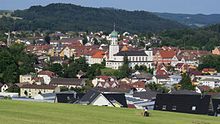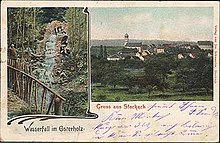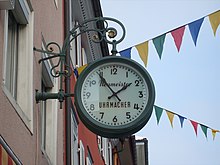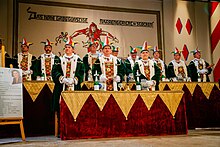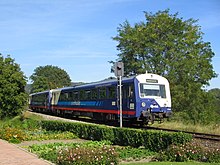Stockach
| coat of arms | Germany map | |
|---|---|---|

|
Coordinates: 47 ° 51 ' N , 9 ° 1' E |
|
| Basic data | ||
| State : | Baden-Württemberg | |
| Administrative region : | Freiburg | |
| County : | Constancy | |
| Height : | 491 m above sea level NHN | |
| Area : | 69.75 km 2 | |
| Residents: | 17,114 (Dec. 31, 2018) | |
| Population density : | 245 inhabitants per km 2 | |
| Postal code : | 78333 | |
| Area code : | 07771 | |
| License plate : | KN | |
| Community key : | 08 3 35 079 | |
| LOCODE : | DE SKH | |
| City structure: | 10 districts | |
City administration address : |
Adenauerstraße 4 78333 Stockach |
|
| Website : | ||
| Mayor : | Rainer Stolz | |
| Location of the city of Stockach in the district of Constance | ||
Stockach is a town in the district of Konstanz in the south of Baden-Württemberg and forms a central center for the surrounding communities. From 1939 to January 1, 1973, the city was the county seat of what was then the Stockach district .
geography
location
Stockach is located in the Hegau , five kilometers northwest of Lake Constance , at an altitude of 452.8 m in the Stockacher Aach valley up to 670.7 m above sea level. NHN in the city forest "Schnaidt".
geology
The extensive urban area, cut up by the Stockacher and Mahlspürer Aach, lies in the area of the molasse ridge that frames the Lake Constance basin and slopes gently to the south. The tertiary subsoil made up of the Lower Freshwater Molasse and Upper Marine Molasse is mainly exposed on the valley slopes, while Ice Age deposits with ground and terminal moraines are present on the ridges and plateau-like hills . In the northern part of the city in the Hoppetenzell district, gravel terraces from the Riss and Würm glaciers stretch out on the tertiary molasse layers . Basin clays and sands that can be assigned to the Würm glacial period are partially preserved in the shape of domed erosion remnants at Hoppetenzell and can be interpreted as the remains of an ice age reservoir.
earthquake
On the evening of November 28th, 1886, a wave-like earth movement in the so-called Stockacher Fault caused a local earthquake from southeast to northwest . At 10:57 p.m., the first of three impacts that were consecutive within five to six seconds woke the population up. In the village about four kilometers away, winter traces could still be clearly felt. This fault line probably runs parallel to the Leiblach line north of the Nellenburg to the southwest, probably crosses the northern continuation of the Überlingerseetal and can then be traced as far as the Steißlingen area.
On November 16, 1911, at 10:25 p.m., the earth shook in Stockach: two tremors terrified the visitors to the Martini market, they lasted up to 25 seconds; an aftershock followed at around 3 a.m. The quake, with its center near Ebingen , was described as "one of the most important in Central Europe for a long time". Many buildings and especially the Catholic town church were severely damaged; the total damage was 38,963 marks.
Another earthquake was felt on the night of April 18, 1961 at around 1:15 a.m. it was preceded by a few seconds of rolling. The quake only caused minor damage.
City structure
The city of Stockach consists of the core town, the formerly independent communities Espasingen , Hindelwangen , Hoppetenzell , Mahlspüren im Hegau , Mahlspüren im Tal , Raithaslach , Wahlwies , Winterspüren and Zizenhausen as well as 79 other villages, hamlets, Zinken, farms and houses.
The Wolfertshausen desert lies in the area of the former municipality of Mahlspüren in the valley . The village of Rissorf has risen up in Stockach and the village of Brändlishofen is located in the area of the municipality of Stockach within the limits of November 30, 1971. In the area of the former municipality of Wahlwies is the abandoned village of Forsterhof. The abandoned farm Daxberg is in the area of the former municipality of Winterspüren and the abandoned villages of Sennhof and Sonnenbühl are in the area of the former municipality of Zizenhausen.
| coat of arms | district | Population (2009) |
Area ( hectares ) |
|---|---|---|---|
| Stockach (core city) | 8200 | 920 | |
| Espasingen | 670 | 950 | |
| Hindelwangen | 1430 | 950 | |
| Hoppetenzell | 590 | 400 | |
| Grinding in the Hegau | 460 | 420 | |
| Grinding traces in the valley / Seelfingen | 610 | 710 | |
| Raithaslach | 360 | 210 | |
| Wahlwies | 2160 | 900 | |
| Winter sensations | 860 | 1200 | |
| Zizenhausen | 1310 | 210 |
history
Grave finds from the Hallstatt period (700 BC), the Celts (4th century BC) and the Alemannic period (400 to 800 AD) can be found in the suburb of Rissorf. Small finds also show that the area was also settled in Roman times (approx. 10 BC to 400 AD). A Roman manor was found in Wahlwies .
Between 750 and 1056 the Nellenburg was built and expanded. In addition to an older village in the Stockacher Aach valley at the intersection of two former Roman roads , the Counts of Nellenburg founded the town of Stockach on a protected hill in the middle of the 13th century according to a simply structured plan. Since 1275 the Stockach office existed in the county of Nellenburg , in 1278 (probably) or 1283 (occupied) Stockach received town charter when Count Mangold von Nellenburg had a contract signed with the words datum et actum in civitate stoka .
In 1351 Kuony von Stocken (sometimes called Hans Kuony) is said to have received the privilege of court of fools for his wise advice at the Battle of Morgarten in 1315. The privilege not received is considered to be the origin of today's Stockach jester's court .
After the third line of the Counts of Nellenburg died out, Stockach and the Landgraviate of Nellenburg passed to the Barons of Tengen . In 1465 Johannes von Nellenburg-Tengen finally sold the Stockacher Land including the city for almost 38,000 guilders to the Habsburgs and the county of Nellenburg came to Austria . The Upper Austrian provincial bailiffs ruled in Stockach for hundreds of years. The House of Habsburg remained the rulers of the city and provinces ( Upper Austria ) until 1805 .
In 1499 it became clear that the rule of the Austrians did not bring security alone. In the course of the Swiss War (also known as the Swabian War), the Swiss advanced into the Hegau - and to the gates of Stockach. Stockach was besieged in vain. An event that the so-called “Swiss holiday” is a traditional event that still reminds us today.
In 1704, during the War of the Spanish Succession (1701–1714), the Bavarian Elector Max Emanuel Stockach largely burned down. In 1770 the Habsburg Archduchess Marie-Antoinette spent the night on her way to the wedding with the French heir to the throne in Stockach, Habsburg. At that time Stockach was part of Swabian Austria and an important road junction between Ulm, Schaffhausen, Tuttlingen and Constance. This is where stagecoach traffic crossed on the Vienna-Paris / Brussels, Stuttgart-Zurich and Ulm-Basel routes. The entire truck traffic had to torment their way up the Kirchhalde here, with frequent damage to the wagons. The local craftsmen, like the ropemaker who has lived here since 1790, earned well from the through traffic.
Turbulent times began for Stockach with the French Revolution (1789 to 1799) and with Napoleon Bonaparte . In the war year 1799 the front line of the Austrians fighting each other in the Second Coalition War under Archduke Karl and the French under General Jourdan lay between Stockach and the Witthoh . On March 25, 1799 there was the battle of Stockach and Liptingen in which the field marshal lieutenant in the service of the Habsburgs, Karl Aloys Prince of Fürstenberg , fell and was brought to the city by his soldiers to be laid out. In the course of the battle, the Austrians won a victory over the French. However, this luck did not last long: When Napoleon crowned himself King of Italy in 1804, war broke out again with Austria. The southern German states of Bavaria , Württemberg and Baden joined France , strengthened by the Reichsdeputationshauptschluss . In 1805, the end of Austrian rule in southern Germany was sealed, Napoleon now appeared as a reformer of Europe and rewarded his war partners with the former Swabian-Austrian territories. At that time Stockach initially fell to Württemberg. On November 23, 1810, the Stockacher Oberamt was handed over to Baden. On March 9, 1848, in the course of the bourgeois revolutionary uprising, the German Republic was proclaimed for the first time in Germany from the Dandler balcony in Stockach, when Joseph Fickler , the editor of the Konstanzer Seeblätter , gave a fiery speech in front of 6000 enthusiastic men from all over the lake district held. But the revolutionary mood was soon stifled by Bavarian, later Württemberg and Prussian troops. At the end of 1851 the last occupation troops withdrew.
In the middle of the 19th century, industrialization began in Stockach, industrial companies that came into being in the Aach valley and Stockach citizens built magnificent houses such as the Villa Fahr and the Villa Hablitzel , which today contrast with the town houses in the upper town. In 1890 a branch of the Schiesser jersey factory from Radolfzell was established (until 1995), and in 1892 Stockach's most important industrial company, the Fahr iron foundry , went into operation (until 1985). Furthermore, traditional hotels were built, the Radolfzell – Stockach railway line with the station building was opened in 1867 and road construction was pushed ahead. In 1844, for example, the less steeply rising city wall (Neue Strasse) was expanded into a street. In 1913 Grand Duchess Hilda von Baden visited Stockach. In 1923, the Stockach emergency money came into circulation.
During the Second World War , Stockach was the target of two air raids on February 22 and 25, 1945, as part of the Allied Operation Clarion , a joint venture between the US and British air forces. Bombers dropped high explosive bombs on both days , there were 24. The target of the attacks were the station area and the machine factory in Fahr, where castings for tanks were produced. Stockach was the first town in the Lake Constance area to be captured on the evening of April 21, 1945 by a motorized unit of the French Army under General Jean de Lattre de Tassigny , whereupon attacks on the civilian population occurred. In total there were 50 to 60 rapes. On the evening of April 22nd, the French moved on towards Überlingen, while Mayor Adolf Wendling was taken to Tuttlingen as a hostage and Ernst Sigel was appointed as the new mayor. A group of the Waffen SS coming from the Radolfzell barracks managed to advance into the liberated Stockach on April 23 and kill five French soldiers. The SS also carried out a massacre of 20 foreign forced laborers and prisoners of war who were provisionally buried in the city garden. On April 24th, the French troops entered Stockach again. As an act of revenge, ten prominent Stockach men were taken hostage, who were to be shot immediately. There were also threats to burn the city down. The then 36-year-old parish administrator Alois Mutz, the new mayor Ernst Sigel and others succeeded in preventing the French from doing this by declaring under oath that the Stockachers were innocent of these crimes. A monument erected in 1995 in the Stadtgarten commemorates the efforts of Alois Mutz and Ernst Sigel after the end of the war. Stockach was part of the French zone of occupation after the war .
Thirteen stumbling blocks in Hauptstrasse and Tuttlinger Strasse commemorate some of the victims of the National Socialist dictatorship in Stockach .
From 1936 to 1972 Stockach was the district town of the Stockach district . After the dissolution in the course of the district and administrative reform of January 1, 1973 Stockach came to the district of Constance.
In the fifties and sixties there were up to 1200 pupils or students at the private long school in Osterholz. This technical school no longer exists today.
On October 1, 2010, the historic old town narrowly escaped a fire disaster: In the Upper Town, where the houses are mostly assembled at the gable, there was a major fire in Kronengasse at “Alt Stocken” on Gustav-Hammer-Platz.
History of the districts
- Espasingen
902 "Aspensinga", probably from the personal name Aspasius . Presumably a former Alemannic ducal estate, owned by the Counts of Nellenburg and the St. Georgen monastery. The lords of Espasingen were noblemen from 1106–1169, ministerials from 1263–1395, and later evidently citizens of Stein am Rhein . The lower court had been held by the Lords of Bodman since the 15th century at the latest , the taxes went to the Hegau knighthood , all other sovereign rights lay with the Landgraviate of Nellenburg . With this Espasingen fell to Württemberg in 1806 and to Baden in 1810. The castle of the Lords of Bodman served as a brewery from 1939 to 1968 and is now largely empty.
- Hindelwangen
The place was first mentioned in 1138 as "Huntwanga", "Hundelwanc" (1211) later "Hindelwang" (1269). Formerly owned by the Salem Imperial Abbey . There is a document from 1211 which confirms the presence of the knight Heinrich von Hundelwanc as part of a donation. Lords of Hindelwangen mentioned in 1214 and at the beginning of the 13th century, but cannot be classified with certainty. Also belonged to the Landgraviate of Nellenburg (see above).
- Hoppetenzell
Hoppetenzell is mentioned in a document for the first time in 777 in the will of the abbot Fulrad of the St. Denis monastery (near Paris). Accordingly, the monastery owned a patch in Hegau, which is called "Adelungcella" (or "Adelungscella" or "Adalongo cella", from the personal name Adalun ). There is evidence that it is the present-day town of Hoppetenzell. 856 “Adalungicella”, 866 “Hadalongcella”, 1275 “Celle”, 1420 and 1456 “Zell im Madach ”, 1493 called “Hoppentzer Zell im Madach”; the origin of the name form is not clear. The place was given to Fulrad by Adalung , Bishop of Eichstätt. Later it was owned by a duke. In 1448 the Lower Court owned the Johanniterkommende Überlingen, probably from a donation from the Lords of Bodman. All other rights were with the Landgraviate of Nellenburg (see above).
- Grinding in the Hegau
In the 13th century "Walsburon", 1291 "Walsburron", 1360/70 "Malsburren", otherwise until the beginning of the 17th century spelling predominantly with "W". The derivation of the personal name Walah is questionable. It used to be owned by the Counts of Nellenburg and the Bishop of Constance. Burgstall and Lower Court in 1603 by the guardians of Albrecht Hans v. Reischach-Immendingen sold to Archduke Maximilian, since then to the Landgraviate of Nellenburg (see above), which owned all other rights.
- Grinding traces in the valley / Seelfingen
1091 "Madelesprun", 1167 "Madilsburran", 1169 "Madilsbiuron", from the personal name Madel / Mada-lo . Formerly owned by the Counts of Nellenburg. Lower court in aristocratic possession, 14th century probably Lords von Heudorf, 1479–1803 owned by the Überlingen Hospital, presumably through purchase from the Lords von Hasenstein. Blood ban in the Landgraviate of Nellenburg. Mahlspüren came to Baden in 1803.
1155 "Raithaselah". It was formerly owned by the Konstanz Cathedral Provost and the Salem and Petershausen monasteries . At the latest in 1307 it belonged to the Landgraviate of Nellenburg (see above), which had all sovereign rights there.
- Wahlwies
839 "Vvalahvis", 946 "Vvalavvis", 1247 "Walewis". Place name cannot be interpreted with certainty, possibly derived from ahd. Walah = Romane, Welscher. Two battles took place here: 355 against the Romans and 915 against the diocese of Constance to restore the Swabian duchy . Alemannic duke property, later property of numerous noble families as well as the monasteries of St. Georgen in the Black Forest and St. Blasien. Diets of the Swabian Duke were held in Wahlwies. Perhaps local lower nobility in the 13th / 14th centuries. Century Lower court rule since the 15th century in the hands of the Lords of Bodman, previously the Lords of Homburg . Headed for knighthood, Bodman's blood spell as a Nellenburg fiefdom and Nellenburg itself each had half. Wahlwies came to Württemberg in 1806 and Baden in 1810. Wahlwies is best known for the Pestalozzi children's and youth village there and a Waldorf school .
- Winter sensations
1101 "Ginteres-bouron", "Wintersbouron" [ou = u above the o ], 1275 "Winterbúrron". Formerly property of the Allerheiligen monastery in Schaffhausen. Noble gentlemen from Winterspüren around 1100. Lower court presumably in the hands of the Lords of Hohenfels, probably acquired by Duke Sigmund of Austria in 1477, to the Landgraviate of Nellenburg (see above), which had all other rights.
- Zizenhausen
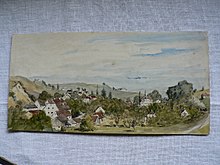
1227 "Zitzenhausen". Belonged with all rights of the Landgraviate of Nellenburg (see above), the lower court was left in 1787 to the district judge Carl Anton von Krafft , who had been the landlord since 1781. The village of Zizenhausen has around 1200 inhabitants. The place is known for the Zizenhausen terracottas from a 19th century factory. Some of these clay figures, which are highly coveted by collectors, can be admired in Zizenhausen Castle and the Stockach City Museum. In addition to numerous representations, the “ Basel Dance of Death ” is particularly well known. The place is seven kilometers north of Lake Constance in Hegau . The “ Heidenhöhlen ” in the local area are geologically interesting .
Incorporations
In the course of the regional reform of Baden-Württemberg in the 1970s, Hindelwangen on December 1, 1971, winter traces on July 1, 1972, Espasingen and Mahlspüren im Tal on January 1, 1973, and Mahlspüren im Hegau, Raithaslach and Zizenhausen on January 1, 1974 on January 1, 1975 Hoppetenzell and Wahlwies incorporated into Stockach.
The incorporated municipalities form localities within the meaning of the Baden-Württemberg municipal code, each with its own local council and mayor as its chairman.
Population development
In 1797 140 hearths were registered in Stockach, which corresponds to about 900 inhabitants. During the district reform of Baden-Württemberg in 1973 , Stockach was the smallest district town in Baden-Württemberg, with a population of 6,500 at the time. As of December 31, 2009 Stockach had a total population of 16,618 people.
Religions
In Stockach there are two Protestant churches - in Stockach and Wahlwies - and several Catholic churches in the various districts. The city is part of the Überlingen-Stockach church district of the Evangelical Church in Baden , based in Salem.
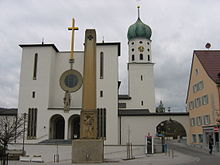
The following churches and religious communities are represented in Stockach:
- Roman Catholic Church
- Evangelical Church in Baden
- Free Christian Church
- Jehovah's Witness
- New Apostolic Church
politics
Municipal council
In addition to the mayor as chairman, the municipal council has 31 members. The local elections on May 26, 2019 led to the following result:
| Party / list | Share of votes | Seats | +/- |
|---|---|---|---|
| CDU | 38.7% | 11 | - 2nd |
| FWV | 22.2% | 6th | - 1 |
| GREEN | 18.5% | 5 | + 1 |
| SPD | 14.8% | 4th | - 1 |
| FDP | 5.8% | 2 | ± 0 |
mayor
The first Ammann Stockachs mentioned was Christoph Reichlin, who directed the fortunes of the city in 1522. The self-government of the municipalities was expanded with the municipal ordinance at the end of the 18th century , the Ammann was replaced by the mayor. The first Mayor of Stockach was Ignaz Khuene (Khiene), from 1787 to 1790 at the head of the city administration.
- July 27, 1895 to October 1922: Carl Walcker
- November 1922 to May 20, 1933: Max Lang
- May 22, 1933 to July 31, 1938: August Hermann
- August 6, 1938 to April 23, 1945: Adolf Wendling
- April 29, 1945 to June 26, 1946: Ernst Sigel
- June 30, 1946 to 1969: Dr. Alois Deufel
- 1970 to 1993: Franz Ziwey
- since 1993: Rainer Stolz
On September 27, 2009, Rainer Stolz was confirmed in his office as mayor with 63.7 percent of the votes cast and a voter turnout of 64.83 percent. In 1993 he replaced Franz Ziwey after 24 years in office.
Administrative community
The city is also the seat of an agreed administrative community with the communities Bodman-Ludwigshafen , Eigeltingen , Hohenfels , Mühlingen and Orsingen-Nenzingen with (2005) a total of around 30,570 inhabitants. The administrative community was constituted on October 1, 1975.
coat of arms
The blazon of the coat of arms reads: “In gold, a silver sloping bar, covered with a red branch, above and below each a four-ended blue stag pole lying to the right .” It is talking about the stick-acher branch .
Town twinning
Since 1972 a town partnership has been maintained with the French town of La Roche-sur-Foron , located in Haute-Savoie .
Culture and sights
Stockach sees itself as the "gateway to Lake Constance". For this reason, a work of art of the same name was placed at the southern exit of the city in 2010.
The Stockach fruit tree nature trail leads through an area of around five hectares. Here, 70 different types of fruit can be viewed, tasted and determined. Above all, old varieties typical of the cultural landscape on Lake Constance were partially replanted here.
music
- Choirs: Eintrachtchor 1836, chamber choir, six singing associations.
- Orchestra: Wahlwies accordion orchestra, chamber orchestra, music school, eight music associations, two shawm groups
- Glasperlenspiel , German electro-pop duo
Museums
The Stockach City Museum is located in the Old Forestry Office, on the 1st and 2nd attic floors above the city library.
Buildings
- The Catholic Church of St. Oswald with its baroque onion dome is located on the so-called Kirchhalde. A fierce dispute raged in Stockach in 1931/1932 about the necessary new building for St. Oswald: the pastor and the foundation council wanted to build a modern church based on the design by architect Otto Linder . A couple of Stockachers fought to keep the landmark and got a referendum from the archbishop. So a compromise solution came about: the reconstruction of the baroque onion dome with a modern nave in the style of the new objectivity. In the vestibule there are two baroque epitaphs by Joseph Anton Feuchtmayer and Johann Georg Dirr .
- The Protestant Melanchthon Church from 1883/1884 was expanded in 1962.
- Loreto chapel (18th century) with a baroque crucifixion group and a nurse organ from 1661, the oldest playable organ in Baden
- Catholic Church of St. Michael in Hindelwangen with Pietà (around 1500) and protective coat Madonna (relief by Hans Ulrich Glöckler, 1610)
- The Herz-Jesu-Kirche is located in Zizenhausen, Sennhofstraße . It was built in 1895 in the neo-Gothic style and northward. Your choir flank tower was built after 1913. The furnishings come from the time it was built: carved altars, gallery and pulpit and figurative painting on the wall around the choir arch.
- Nellenburg castle ruins
- Espasingen Castle (most recently brewery and malt house)
- Hans Kuony Fountain by Werner Gürtner (1973)
- War memorial in memory of the dead of the First World War. It is on the main street in front of the St. Oswald Church.
- Stockach is home to two sculptures by the sculptor Peter Lenk , who lives in nearby Bodman-Ludwigshafen , the voucher of honor and the U20 submarine .
- Germany's oldest still functioning electro-automatic outdoor clock is located in Stockach. It was put into operation in 1895.
Regular events
Stockach is known not least for its Swabian-Alemannic Carnival with the annual “ Stockacher Fools Court ” at the “ Schmotzige Dunschtig ”, which has existed since 1351. It goes back to an incident in which the court jester Kuony von Stocken pointed out to Archduke Leopold I of Austria before the Battle of Morgarten against Switzerland: “You know how to get into Switzerland, but not how to get out. “The battle was lost. Duke Albrecht the Wise then granted Stockach the fool's court privilege for all time. Every year the jester's court selects a new defendant who is accused by the plaintiff, defended by the advocate, and then defended himself in the main hearing in public and broadcast by SWR television. The judgment by the judge provides as a punishment, depending on the severity of the guilt, one or more buckets of wine (Austrian capacity of 60 liters) as penance by the Laetare day.
Every year in summer (end of June) the successful resistance against the Swiss siege during the Swabian War (1499) is commemorated on the "Swiss Holiday" and celebrated with a street festival.
Economy and Infrastructure
Stockach lives from tourism and a number of companies that are internationally active. So has z. E.g. the ETO group has its headquarters there as well as a plant of the armaments company Rheinmetall . The “Hardt” industrial area and the “Blumhof” industrial area are each located on a motorway entrance. In the Hindelwangen district there is the “Himmelreich” industrial park.
traffic
The city of Stockach can be reached via two exits from the federal highway 98 . The federal highways 14 , 31 and 313 cross in the village .
Since 1996, the city has been connected to local rail transport again by the railway line to Radolfzell, known as the Seehäsle .
The “ Hegau-Panorama-Weg ” , which leads from Engen for around 175 kilometers through the Hegau, ends in Stockach .
Court, authorities and institutions
Stockach is the seat of the Stockach District Court , which belongs to the District Court district of Konstanz .
The Konstanz District Office has a branch office for vehicle registrations and driving licenses, which is housed in the town hall.
Postal services
Stockach was already an important post office in the 16th century. For centuries, large, interstate equestrian and postal courses on the Ulm - Basel , Stuttgart - Zurich and Vienna - Paris routes converged here. In 1845 the local post office still had 60 horses.
Before 1821, private individuals had to hand in their mail at the Stockach post office themselves. Then the establishment of an official messenger establishment made it possible for private individuals to hand over their mail to an official messenger. Initially, he brought the post to the Stockacher Post Expedition twice, later three times a week.
In the 1850s the official messenger agency was closed due to the steadily increasing correspondence, its services were transferred to the post office and on May 1, 1859 the rural postal agency was brought into being. Five messenger districts were set up in the Stockach district:
- Messenger District No. I.
- Monday / Wednesday / Friday: Stockach – Hindelwangen – Zizenhausen – Mahlspüren – Raithaslach – Münchhöf – Hoppetenzell – Stockach
- Tuesday / Thursday / Saturday: Stockach – Mahlspüren im Tal – Winterspüren– Zoznegg - Schwackenreute –Stockach
- Messenger District No. II
- Monday / Wednesday / Friday: Liptingen - Schwandorf - Mainwangen - Mühlingen - Gallmannsweil - Liptingen
- Tuesday / Thursday / Saturday: Liptingen – Schwandorf– Hecheln - Heudorf - Rorgenwies –Liptingen
- Messenger District No. III
- Monday to Saturday: Espasingen– Bodman - Stahringen –Wahlwies– Orsingen - Nenzingen –Risstorf – Stockach
- Messenger District No. IV, from Aach
- Messenger District No. V, from Eigeltingen
Mail items that had been thrown into the respective letter tray on site were given a clock wheel stamp by the postman before they were forwarded : For example, mail items in Hindelwangen received the 1st , in Gallmannsweil the 8th and in Orsingen the 22nd.
Educational institutions
In the city center there is a primary and secondary school , the Nellenburg grammar school , a secondary school , a special needs school, an e-school, the vocational school center, a language therapy school, the technical school for agriculture, a music school and an adult education center (VHS) for adult and Continuing education . The primary school has been independent since August 2015. The Haupt- und Werkrealschule continues with the Realschule in the Nellenburg School Association.
In the Wahlwies district there is a primary school and a free Waldorf school .
In Zizenhausen there is the Anton-Sohn-Schule, this elementary and secondary school is named after the well-known son of the village of Zizenhausen. The first two classes of the Anton-Sohn-Schule are taught in the Mahlspüren district in Hegau. Another elementary school is located in the Winterspüren district. The first class is also taught in the Hindelwangen district. After the first grade, the students go to the central elementary school in the city center.
The modern city library, newly established in 2002, offers over 25,000 media, free internet access and numerous events to promote reading.
Personalities
Honorary citizen
- Fritz Geiges (1853–1935), honorary citizen of Raithaslach, glass and monumental painter, restorer for glass painting and local historian.
- 1993: Franz Ziwey (* 1932), mayor of Stockach for 24 years
- 2017: Heiner Wagner (1931–2019), city councilor, advocate in the jester's court Stockach, art patron
sons and daughters of the town
- Kuony von Stocken (sometimes called Hans Kuony ), founder of the jester's court in Stockach
- Philipp Wilhelm Matthias Curtius (1737–1794), born in Stockacher, after 1761 founder of a wax museum in Paris and stepfather of Marie Tussaud
- Joseph Ignaz von Buol-Berenberg (1749–1817), Lieutenant Field Marshal , City Commandant of Prague
- Caroline Schleicher (1794–?), Clarinetist
- Anton von Stabel (1806–1880), constitutional lawyer and head of government
- Gideon Weizel (1807–1872), State Councilor
- Friedrich Ammermüller (1809–1898), physician, teacher, entrepreneur, publicist and member of parliament
- Richard Stocker (1832–1918), born in Wahlwies, was a "grand ducal administrative officer" in Waldshut and a famous tenor (called the "Hegausänger") of his time; friends with Joseph Victor von Scheffel and Joseph Stöckle .
- Emil Lugo (1840–1902), painter
- Julius Pecher (1842–1901), court architect and writer
- Rudolf von Buol-Berenberg (1842–1902), President of the Reichstag from Zizenhausen
- Hermann Ludwig Pfeiffer (1858–1924), Oberamtmann of Baden
- Max Cramer (1859–1933), teacher and genealogist
- Albert Gockel (1860–1927), physicist
- Karl Friedrich Gegauf (1860–1926), born in Wahlwies, invented and built the world's first hemstitch sewing machine, thereby laying the foundation for the Bernina sewing machine factory
- Karl Futterer (1866–1906), geologist, mineralogist and Asian researcher
- Oskar Keller (1877–1959), pharmacist, food chemist and university professor
- Paul Pfeiffer (1879–1957), metal artist
- Wilhelm Mattes (1892–1952), born in Winterspüren, politician (DVP, later GB / BHE), member of the state parliament
- Sofie Regenscheit (1893–1969), born in Winterspüren, member of the SPD in the Baden state parliament from 1919 to 1921
- Willi (actually: Wilhelm) Hermann (1907–1977), composer of several carnival songs known to this day in the Lake Constance area.
- Andreas Renner (* 1959), politician (CDU) and former Minister of Social Affairs of Baden-Württemberg
- Martin Hahn (* 1963), politician, member of the state parliament
- Wolfgang Reuther (* 1963), politician (CDU) and member of the state parliament
- Sebastian Padotzke (* 1971), keyboardist from Reamonn
- İsmail Şahin (* 1975), actor
- Daniel Grunenberg (* 1988), member of the electro pop duo Glasperlenspiel
Personalities who have worked on site
- Anton Sohn (1769–1840), creator of the Zizenhausen terracottas , lived and worked in the Zizenhausen district from 1799 until his death
- Gustav Rockholtz (1869–1938), painter, lived and worked in Stockach from 1919 until his death
- Carl Anton von Krafft (1743–1830), senior magistrate and district judge of the county of Nellenburg and lord of the manor of Zizenhausen
- Alois Mutz (1909–2005), parish administrator of St. Oswald from 1943 to 1946 , holder of the Federal Cross of Merit, in April 1945 one of the rescuers of Stockach and namesake of a street in Stockach
- Matthias Reim (* 1957) lives with his girlfriend Christin Stark in Stockach
- Marc Dumitru (* 1986), actor and actor in Das Haus Anubis , grew up in Stockach
literature
- Kurt Schmid: Zizenhausen. The youngest municipality in the Landgraviate of Nellenburg . City of Stockach (Ed.), Primo Verlag, A. Stähle, Stockach, 2011, ISBN 978-3-00-030815-4 (Hegau Library Volume 143)
- Fredy Meyer: Wahlwies. A village and its history . Engen: Stähle, 1990, XIII, 509 S., ISBN 3-921413-26-5 (Hegau Library; Volume 67)
- Hartmut Rathke: Stockach in the age of the world wars . (= Hegau Library; Volume 123). Constance 2004, ISBN 3-00-014732-2
- Hans Wagner: From Stockach's past . Published by the Association for the History of Hegaus e. V. (= Hegau Library; Volume 11). 1967 (most of the information on history and personalities is from this book)
Web links
Individual evidence
- ↑ State Statistical Office Baden-Württemberg - Population by nationality and gender on December 31, 2018 (CSV file) ( help on this ).
- ↑ Stockach - The gateway to Lake Constance. Urlaubsmagazin 2015/16, p. 43: "Facts and Figures".
- ↑ The topography of Stockach at www.leo-bw.de; accessed on November 26, 2018.
- ↑ See the annual books of the Verein für vaterländische Naturkunde in Württemberg , Volume 63, 1907, p. 168.
- ↑ Cf. sporadic earthquake of November 28, 1886 in Stockach. In: Negotiations of the Natural Science Association in Karlsruhe , Volume 10, 1888, pp. 121f.
- ^ See Journal of the German Geological Society , Volume 63, 1912, p. 536.
- ↑ Hans Wagner: The earthquake of November 16, 1911. In: From Stockach's past. Hegau Library, Volume 11; Association for the history of the Hegaus e. V., Radolfzell, 1967. pp. 342ff.
- ↑ Home chronicle. In: Hegau - magazine for history, folklore and natural history of the area between the Rhine, Danube and Lake Constance. Self-published by the Hegau history association Singen e. V., Issue 1/2 (11/12) 1961, p. 192.
- ^ The state of Baden-Württemberg. Official description by district and municipality. Volume VI: Freiburg administrative region. Kohlhammer, Stuttgart 1982, ISBN 3-17-007174-2 . Pp. 777-784.
- ↑ a b Ortsteile ( Memento of the original from January 11, 2015 in the Internet Archive ) Info: The archive link was inserted automatically and has not yet been checked. Please check the original and archive link according to the instructions and then remove this notice. , accessed December 2, 2010.
- ↑ Jürgen Hald: Roman settlement remains in the "Hafenäcker" corridor near Wahlwies. In: Archaeological excavations in Baden-Württemberg 2009. Stuttgart 2010, pp. 187–189.
- ↑ a b c d e f g h Matthias Biehler (bie): A breath of history blows through the city. In: Südkurier from October 20, 2008.
- ↑ Max Miller , Gerhard Taddey (ed.): Handbook of the historical sites of Germany . Volume 6: Baden-Württemberg (= Kröner's pocket edition . Volume 276). 2nd, improved and enlarged edition. Kröner, Stuttgart 1980, ISBN 3-520-27602-X , p. 763.
- ↑ Peter Steuer, Konrad Krimm: Front Austrian Government and Chamber 1753–1805: Oberamt Stockach and City of Konstanz. Publications of the State Archives Administration Baden-Württemberg 50/7. Verlag Kohlhammer, Stuttgart 2008, ISBN 978-3-17-020483-6 .
- ↑ a b Lisa-Maria Peschges: panting on the way to the church. In: Südkurier of September 7, 2012.
- ↑ a b Nadja Grintzewitsch: Stockachers were once proud Swabians. In: Südkurier from December 1, 2010.
- ↑ Hans Wagner: From Stockach's past.
- ↑ (sw): Monuments have opened. In: Radolfzeller Wochenblatt of September 7, 2011.
- ↑ 725 years of Stockach.
- ↑ Simone Ise: Magnificent villas in the lower town. In: Südkurier of September 7, 2011.
- ↑ Georg Becker: A splinter reminds of the bombs. In: Südkurier from February 25, 2010.
- ^ Including pharmacist Walter Braun, Dr. Wilhelm Heinen, Alois Lang, Hermann Muffler, Emil Neumeister and the head of the tax office, Max Seilnacht
- ↑ Waltraud Schwarz: A city escapes destruction. In: Südkurier from May 7, 2005.
- ↑ a b Matthias Biehler (bie): Memory of the “Savior from Stockach” .. In: Südkurier from August 16, 2007.
- ^ A b Pastor Alois Mutz died in Überlingen. In: Südkurier of November 22, 2005.
- ↑ Hartmut Rathke: And suddenly the French are at the door. In: Südkurier of April 21, 2005.
- ^ Peter Filz: Major fire in the historic old town. In: Südkurier of October 4, 2010.
- ^ The state of Baden-Württemberg. Volume VI. P. 778f.
- ^ The state of Baden-Württemberg. Volume VI. P. 779.
- ^ The state of Baden-Württemberg. Volume VI. P. 779f.
- ↑ a b The state of Baden-Württemberg. Volume VI. P. 780.
- ^ The state of Baden-Württemberg. Volume VI. P. 781.
- ^ The state of Baden-Württemberg. Volume VI. P. 782f
- ^ The state of Baden-Württemberg. Volume VI. P. 783
- ^ The state of Baden-Württemberg. Volume VI. P. 784
- ^ Federal Statistical Office (ed.): Historical municipality directory for the Federal Republic of Germany. Name, border and key number changes in municipalities, counties and administrative districts from May 27, 1970 to December 31, 1982 . W. Kohlhammer, Stuttgart / Mainz 1983, ISBN 3-17-003263-1 , p. 502, 519 f .
- ↑ Franz Ziwey: The end of the district Stockach - a review . In: Singener Wochenblatt , 1999
- ↑ Population status Stockach, State Statistical Office Baden-Württemberg, Stuttgart ( page no longer available , search in web archives ) Info: The link was automatically marked as defective. Please check the link according to the instructions and then remove this notice. , accessed December 2, 2010
- ↑ State Statistical Office of Baden-Württemberg Final results of the 2019 municipal council elections, City of Stockach
- ↑ Election result at www.stockach.de, accessed on June 17, 2019.
- ^ Hans Wagner: Stockach mayor and mayor elections. In: From Stockach's past. Association for the history of the Hegaus e. V., Radolfzell 1967, pp. 40-46.
- ↑ a b Georg Becker: Ziwey conquers Stockach. In: Südkurier from May 2, 2009
- ↑ Ziwey was elected in November 1969 and was introduced to the office of Mayor of Stockach on January 24, 1970.
- ↑ Gabi Rieger (gri): There is the gate to Lake Constance . In: Südkurier of October 12, 2010
- ↑ Holiday ideas for everything to do with apples. Educational trail, museums and festivals . In: Bodensee Ferienzeitung. Edition 2/2009. Südkurier GmbH Medienhaus, Konstanz 2009, p. 6.
- ^ Website of the Stockach City Museum , accessed on March 24, 2017.
- ↑ Hartmut Rathke: Stockach in the age of the world wars. Pp. 133-138.
- ↑ Stockach, Loretokapelle - On the restoration of the organ by Johann Christophorus Pfleger, Radolfzell 1661. Retrieved on May 23, 2013 from the website of Orgelbau Klais .
- ↑ [ https://www.br.de/mediathek/video/gernstls-deutschlandreise-15062019-von-basel-zum-bodensee-av:5cd2f2af014ac50013826161 BR Mediathek: Gernstls Deutschlandreise | June 15, 2019 From Basel to Lake Constance] Cf. Franz Xaver Gernstl in: Gernstl's trip to Germany . Season 1. Episode 7: From Basel to Lake Constance . Travel documentation. Produced by Megaherz Film und Fernsehen on behalf of Bayerischer Rundfunk . August 2008.
- ↑ Broadcast of the “Stockacher Narrengericht” in the SWR on February 11, 2010 from 8:15 pm to 9:00 pm.
- ↑ Ramona Löffler: Stockach. On foolish waves at the foot of the Nellenburg . In: The region introduces itself. We are here . Special supplement to Südkurier from November 19, 2010, p. 26.
- ↑ Information board at today's Stockach post office in Schillerstraße
- ↑ Dr. Edwin Fecker: The rural postal district of Stockach in circular no. 140 of the “Arbeitsgemeinschaft Baden” in the Bund Deutscher Philatelisten eV (BDPh), autumn 2004; Page 1713ff
- ↑ GuW Stockach. Retrieved November 3, 2017 .
- ↑ At the same time as he was granted honorary citizenship of Freiburg, Geiges also became an honorary citizen of Raithaslach, cf. Schau-ins-Land, magazine of the Breisgau-Geschichtsverein, 1985, p. 299
- ↑ Jörg Braun: “Just not a big fuss” . In: Südkurier of December 16, 2002
- ^ Farewell to Alois Mutz. In: Südkurier from November 25, 2005
- ↑ Marc Dumitru ( Memento of the original from January 12, 2017 in the Internet Archive ) Info: The archive link was inserted automatically and has not yet been checked. Please check the original and archive link according to the instructions and then remove this notice. . AnubisPedia website. Retrieved March 13, 2010.



